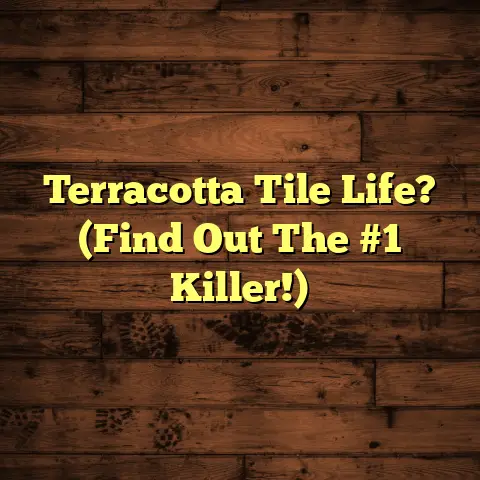Light vs Dark Hardwood: Which Wins? (2024’s Top Look)
Light vs. Dark Hardwood: Which Wins? As a flooring contractor who’s seen it all, from shag carpets to the latest engineered wood, I know how overwhelming choosing the right flooring can be.
Hardwood is a classic for a reason – it’s beautiful, durable, and adds value to your home. But the big question is: light or dark?
In 2024, both light and dark hardwood are HUGE, but for different reasons. The flooring you choose sets the stage for your entire home. It influences the mood, the perceived space, and even how your furniture looks.
This isn’t just about trends; it’s about your style and needs. So, let’s break down the pros and cons of each to help you make the best decision.
Section 1: The Aesthetic Appeal of Light Hardwood
1.1 Defining Light Hardwood
What exactly is light hardwood? We’re talking about woods that are naturally lighter in tone or have been finished to achieve a lighter appearance.
Think maple, ash, birch, and even some oaks that have been bleached or stained. These woods tend to have a more subtle grain pattern compared to their darker counterparts.
- Maple: Known for its creamy white to light brown color and smooth, uniform texture.
- Ash: A light, creamy color with prominent grain patterns.
- Birch: Offers a warm, light yellow tone with a fine grain.
1.2 Visual Characteristics
Light hardwood is all about brightness and airiness. It reflects light, making rooms feel larger and more open. The texture can range from super smooth (like maple) to more rustic with visible knots and grain (like some lighter oaks).
The grain patterns in light hardwood are generally less dramatic than in darker woods, giving a more subtle and understated look.
1.3 Interior Design Compatibility
This is where light hardwood really shines! It’s incredibly versatile and works well with a ton of different design styles:
- Scandinavian: Light wood is a staple of Scandinavian design. It creates a clean, minimalist, and calming atmosphere. Think light walls, natural textures, and pops of color.
- Modern Farmhouse: Light wood floors provide a warm and inviting foundation for this style. Pair it with white shiplap, rustic accents, and comfortable furniture.
- Contemporary: Light hardwood complements the clean lines and neutral color palettes of contemporary design. It adds a touch of warmth without being overwhelming.
Light hardwood also plays well with a variety of color palettes. It looks fantastic with cool blues and greens, warm neutrals, and even bold pops of color. It’s a blank canvas that lets you experiment with your decor.
1.4 Psychological Effects
Color psychology is a real thing! Light colors tend to evoke feelings of:
- Spaciousness: Light floors make rooms feel bigger and more open.
- Tranquility: They create a calming and relaxing atmosphere.
- Positivity: Light colors are associated with happiness and optimism.
If you want your home to feel like a bright and airy sanctuary, light hardwood is a great choice.
1.5 Trends and Popularity in 2024
In 2024, light hardwood is still going strong. I’m seeing a huge demand for wide-plank, light oak floors with matte finishes.
This style is all about creating a natural and understated look. I recently saw a stunning example at the International Builders’ Show (IBS) where a builder used light, wide-plank maple throughout an entire home.
It created a seamless and modern look that was both inviting and sophisticated. Interior designers are also loving the versatility of light hardwood.
According to a recent article in Architectural Digest, “Light wood floors offer a blank canvas that allows for endless design possibilities.”
Section 2: The Aesthetic Appeal of Dark Hardwood
2.1 Defining Dark Hardwood
Now, let’s flip the script and talk about dark hardwood. This includes woods that are naturally dark or have been stained to achieve a deeper, richer color.
Popular choices include walnut, cherry, mahogany, and some dark-stained oaks. These woods tend to have a more pronounced grain pattern and a luxurious feel.
- Walnut: Known for its rich, dark brown color and distinctive grain patterns.
- Cherry: A reddish-brown hue that deepens over time, with a smooth, closed grain.
- Mahogany: A deep reddish-brown with a straight, even grain.
2.2 Visual Characteristics
Dark hardwood is all about drama and sophistication. It adds depth and richness to a room, creating a sense of luxury. The texture can range from smooth and polished to more rustic with visible knots and grain.
The grain patterns in dark hardwood are often more prominent, adding visual interest and character to the floor.
2.3 Interior Design Compatibility
Dark hardwood can elevate a variety of design aesthetics:
- Traditional: Dark wood floors are a classic choice for traditional homes. They create a sense of formality and elegance. Pair it with rich colors, ornate furniture, and classic patterns.
- Industrial: Dark hardwood adds warmth and sophistication to industrial spaces. It contrasts beautifully with exposed brick, metal accents, and concrete.
- Eclectic: Dark wood floors provide a grounding element for eclectic designs. They allow you to mix and match different styles and colors without creating a chaotic look.
Dark hardwood works well with both warm and cool color schemes. It looks stunning with jewel tones like emerald green and sapphire blue, as well as with creamy whites and soft grays.
2.4 Psychological Effects
Dark colors evoke different emotions than light colors:
- Cozy: Dark floors create a sense of warmth and intimacy.
- Sophisticated: They add a touch of elegance and luxury.
- Grounded: Dark colors can make you feel more stable and secure.
If you want your home to feel like a cozy and sophisticated retreat, dark hardwood is an excellent choice.
2.5 Trends and Popularity in 2024
While light hardwood is still dominating, dark hardwood is making a comeback in 2024. I’m seeing a trend towards darker, more dramatic floors, especially in high-end homes.
I recently attended a design show in Milan where several designers showcased rooms with dark, wide-plank walnut floors. The look was incredibly chic and sophisticated.
According to a recent report by the National Wood Flooring Association (NWFA), “Dark wood floors are gaining popularity as homeowners seek to create a more luxurious and dramatic look.”
Section 3: Practical Considerations
Okay, aesthetics are important, but let’s get real about the practical stuff.
3.1 Maintenance and Care
This is a big one!
- Light Hardwood: Light floors tend to hide dust and dirt better than dark floors. Scratches and dents are also less noticeable. However, light-colored floors can show stains more easily.
- Dark Hardwood: Dark floors show EVERYTHING. Dust, dirt, pet hair, you name it. Scratches and dents are also more visible. You’ll need to sweep or vacuum more often to keep them looking their best.
I always recommend using a microfiber mop and a pH-neutral cleaner for both light and dark hardwood. Avoid harsh chemicals or abrasive cleaners, as they can damage the finish.
3.2 Durability and Longevity
The durability of your hardwood floor depends on the species of wood and the finish.
- Light Hardwood: Maple and ash are known for their hardness and durability. They can withstand a lot of wear and tear.
- Dark Hardwood: Walnut and cherry are softer woods and may be more prone to dents and scratches. However, a durable finish can help protect them.
No matter what type of hardwood you choose, I recommend investing in a high-quality finish. A polyurethane finish is a good option for its durability and water resistance.
3.3 Cost Analysis
The cost of hardwood flooring varies depending on the species, grade, and finish.
- Light Hardwood: Maple and ash are generally more affordable than walnut and cherry.
- Dark Hardwood: Walnut and cherry are considered premium woods and tend to be more expensive.
Installation costs are generally the same for light and dark hardwood. However, if you choose a more intricate pattern or a wider plank, the installation cost may be higher.
According to HomeAdvisor, the average cost to install hardwood flooring ranges from \$6 to \$12 per square foot, including materials and labor.
3.4 Resale Value
Hardwood flooring is generally considered a good investment that can increase the value of your home.
- Light Hardwood: Light wood floors are a popular choice for many homebuyers, especially those looking for a modern or Scandinavian-inspired home.
- Dark Hardwood: Dark wood floors can also add value to your home, especially if they complement the overall style and design.
Ultimately, the impact on resale value depends on the specific market and the preferences of potential buyers.
Section 4: Real-Life Applications and Case Studies
Let’s get some real-world perspectives!
4.1 Homeowner Experiences
I recently talked to a homeowner named Sarah who installed light maple floors in her living room. She said, “I absolutely love my light wood floors! They make my living room feel so much bigger and brighter. Plus, they’re so easy to clean!”
On the other hand, I spoke with John, who installed dark walnut floors in his dining room. He said, “My dark wood floors look amazing, but they require a lot of upkeep. I have to sweep them every day to keep them looking their best.”
4.2 Designer Insights
I also reached out to a local interior designer, Emily, for her perspective. She said, “When choosing between light and dark hardwood, I always consider the client’s style and the overall design of the home.
Light wood floors are great for creating a bright and airy space, while dark wood floors can add drama and sophistication.”
4.3 Before and After Comparisons
I worked on a project where we replaced old, worn-out carpet with light oak floors in a small apartment. The transformation was incredible! The apartment felt instantly larger, brighter, and more modern.
In another project, we replaced outdated tile with dark walnut floors in a formal dining room. The dark wood floors added a touch of elegance and luxury to the space.
Section 5: Conclusion
So, light vs. dark hardwood: which wins? The truth is, there’s no definitive answer. Both light and dark hardwood flooring have their own unique advantages and appeal.
Light hardwood is great for creating a bright, airy, and modern space. It’s versatile, easy to maintain, and works well with a variety of design styles.
Dark hardwood is perfect for adding drama, sophistication, and warmth to a room. It’s a classic choice that can elevate any space.
Ultimately, the best choice for you depends on your personal style, your home’s design, and your practical needs.
Consider the size of your rooms, the amount of natural light you have, and your lifestyle. Think about the look you want to achieve and the emotions you want to evoke.
Hardwood flooring is a timeless choice that will continue to be popular for years to come. As we move through 2024, I expect to see even more innovation in hardwood flooring, with new colors, textures, and finishes emerging.
No matter what you choose, I’m confident that you’ll love your new hardwood floors for years to come! Good luck with your project!





